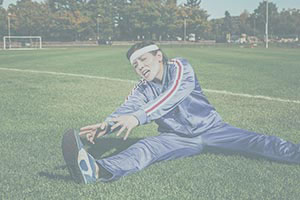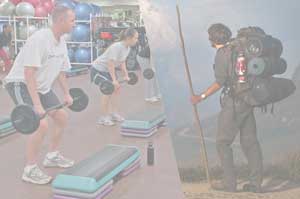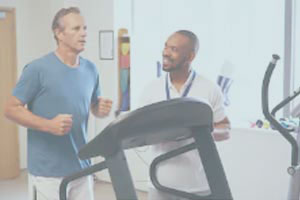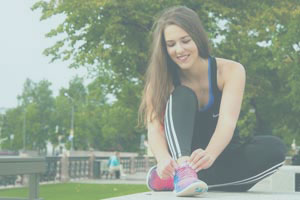


Programs focused on specific aspects of fitness and conditioning, e.g. flexibility, strenght, endurance, or overall fitness.
Programs dedicated to weight-loss specific concerns, such as fat burning, improving metabolism, etc.
Programs intended to strategic prevention of illnesses, such as, diabetes, heart diseases, etc.
Programs designed to minimize barriers and restrictions to movements and enhance active lifestyle.
Programs designed to assess, understand, and improve clients' motivation to exercise and stay active.
A comprehensive assessment is conducted prior to formulation and implementation of a porgram plan. Assessment generally focuses on various factors such as the client's medical, physiological, and psychological profile that provides a complete visual of the client's capacity, motivation, and specific needs.
Every client is different and unique in terms of their backgrounds, goals, and objectives, and Adlul's programs acknowledge them as such. Having understood the details of a client's circumstances and needs, customized programs are designed to include the materials that are best suited for the client.
Programs are 100% evidence-based and only the materials that have been empirically tested to be effective and safe are included in the program.
Goals are determined based on the client's circumstances, background, capacity, and what s/he is trying to accomplish from an exercise program. This goal is what will guide the client throughout the program. Goals are formulated based on the SMARTS Principles:
- Soecific:
- Measurable
- Attainable
- Relevant
- Timely
Research is pretty clear on health benefits of exercise and physical activities. Exercise increases our physiological conditioning, increases productivity, and can also help prevent, reduce the risks of, and often reverse the effects of various chronic diseases.
Regular physical activities can improve your overall heart health by strengthening the heart muscles, increasing blood circulation, lowering the cholesterol level, and improving the blood pressure. Accordingly, Exercise can help prevent and reduce the risks of major chronic heart diseases such as heart attack, arrhythmias (abnormal heart rhythms), and Coronary artery disease (narrowing of the arteries).
Physical activities can help reduce the risks of weight gain and obesity, both major risk factors for many illnesses, by reducing body fat, building muscles, and enhancing the body’s metabolism.
Exercise helps build bone density which has numerous health and productivity benefits and can also prevent many bone-related diseases later in life, such as, osteoporosis.
Exercise can help lower blood sugar level and increased insulin functionality of the body. Therefore, physical activities are frequently prescribed by doctors to diabetic patients and to those trying to avoid diabetes and other metabolic syndromes.
Physical activity can help prevent, reduce, or reverse the effects of many other chronic diseases such as cardiovascular diseases, cancer, hypertension, back pain, and osteoporosis.

Further reading on health benefits of exercise:
Hormones:
Hormones are chemical components created by the various glands of the body (endocrine systems) that act as chemical signals that travels through the bloodstream to regulate various key funcitons of the body, such as, hunger, growth, healing, sleep cycle, sexual drive, as well asl, mood, feelings, and emotions.
Levels of hormones such as, Adrenaline, Cortisol, and Testosterone, within the body can be significant determinants of mood related disorders.
Neurotransmitters:
Neurotrasmitters are chemical molecules created by the brain that acts as messangers communicating between the brain cells and the muscle. Neurotransmitters are key determinants of mental states such as mood, feelings, and emotions. An imbalance of neurotransmitters such as dopamine, serotonin, and norepinephrine within the brain have been found to be associated with depression.
Regular physical activities is proven to have a positive effect on regulating several key hormones and neurotransmitters that are associated with stress, anxiety, and depression.
There is ample scientific evidence that suggests Physical activities increase the levels of several hormones and neurotransmitters responsible for a sense of positive feeling and wellbeing, such as, endorphins, serotonin, norepinephrine, dopamine, glutamate and gamma-aminobutyric acid, while decreasing illness-inducing hormones like cortesol.
Therefore, physical activities are considered an effective means of minimizing the risks of mental illnesses, as well as, reversing some of the effects.
Apart from regulating the chemical balance within the body and the brain in a positive way, exercise can help address the cognitive elements of mental illnesses. In other words, physical activities can reduce the volumes of negative thought patters that stems from mental illnesses by providing us with the much needed distraction from our woes and worries.
Along with helping with the restoration of the chemical balances within the body exercise has proven to help people with quality of sleep in many ways such as:
- help fall asleep more easily
- avoid wakefulness
- improves sleep cycle
- increase the amount of deep sleep
- increase the total amount of sleep
Physical activity can help prevent, reduce, or reverse the effects of many other chronic diseases such as cardiovascular diseases, cancer, hypertension, back pain, and osteoporosis.

Whether you are a Construction Worker or a Gardener who does manual labour work all day, a scientist working in a lab, or an Office Administrator who sits in a chair all day, exercise can help your productivity in so many ways.
Regular physical activities can improve your memory, alertness, and cognitive functioning such as:
Processing Information-
Computing Numbers-
Decision Making-
As a consequence of the points mentioned above, exercise can incrase your energy level that would give you the strenght to work harder and accomplish your professional goals and dreams.
Exercise can also improve your endurance to work longer, reduce fatigue and tiredness.

You can apply all kinds of Onions, Ostrich Eggs, Anti-Wrinkle Creams, and Bonobo Urines to your skin, but the best advice that any Beautician can give you is Regular Exercise
Exercise improves blood circulation, and gives your skin a heavy dose of oxygenated blood, the best nutrient you can provide for a radiant, glowing, healthy looking skin.
The increased blood flow through exercise also supplies more oxygen and other nutrients that nourishes the hair roots, and promotes hair growth.
Exercise enhances detoxication of the body through increased blood circulation, and sweat, and by mobilizing and removing various metabolic toxins and other harmful chemicals accumulated within the body.
Exercise is proven to have a preventive effect on various types of illnesses related to aging, such as Heart diseases, Parkinson’s, Dementia, and Osteoporosis. In addition, exercise, (especially high-intensive interval exercise) causes cells to make more proteins at the mitochondria, which reduces aging at cellular level.

Strategies for Effective Exercise and Physical Activities

Whether you want to go to the gym with your colleagues, do some push-ups on your own, play team sports with your friends, or just go for a walk on a Sunday morning, exercise or physical activities should never ever be percieved as a required chore, or be used as a form of punishment. The only reason you should ever do physical activities is when you think it is fun and enjoyable! Do you know why? Because it IS!

Going to the Gym is a great way to stay in shape and maintain good health, but it may not be the right activity for you. Perhaps your place in the outdoors doing team sports, hiking in the wild, or just going for a walk with your partner everyday after dinner. So, do your experiments with different activities, and pick a few from the activities that you enjoy the most. Remeber, you are doing physical activities because you love it, not because you have to, and the only way to ensure that is when you are engaged in soemthing that you enjoy.

Whether you are trying to lose weight, gain muscles, lower your cholesterol, or improve your flexibility, make sure that your goal is set to be realistic, achievable, and timely, that is in line with your current skill levels, and life circumstances. If you set your goal too high on difficilty level it will potentially cause a decrease in your motivation and enjoyment, and in worst case scinario cause you to drop out.

You maybe trying to lose weight, build muscles, control your blood sugar levels, or improve your conditioning, whatever may be your goal, you must be pantient with the results. Each of these goals will be achieved in due course, you must continue to enjoy your activities, and avoid focusing too much on results or trying anything extravagant like taking up extreme diet programs or intensifying your workout routines on an unrealistic levels when you don't see noticable resutls after a few weeks.

Whatever goal that you have set for yourself for the future, you must learn to be happy without them RIGHT NOW! Yes, that dress that will finally fit you will make all the hard work totally worthwhile, but you don't need to wait for that to be happy. You can be happy and complete right now. And when you will have finally achieved your goal, it will be a bonus, and you are going to feel that much more complete. Many people make the mistake of suspending all their happiness until their goal is accomplished, while making tremendeous dietary sacrifices and enduring severe physical punishments. Remember, the journey itself should be just as enjoyable as reaching the destination!

Remember, you are beautiful right now. So, don't feel that you need to lose weight or gain muscle to be beautiful. Because if you are miserable with your excessive weight, you are going to remain miserable without it.

Physical Barriers to exercise may include any form of disability and/or limitatino of mobility. It is important to pay attention to issues related to these barriers while formulating your exercise program plan.

Mental illness symptoms, or lesser factors such as our feelings, and moods affect our motivation to exercise significantly. For example, depressive symptoms can drastically decrease in the levels of dopamine, endorphins, and serotonin, resulting us to feel less excited about physical activities. In other words, when you are sad or in a bad mood, you may find it more difficult to go for a run. Such factors should be taken in to consideration seriously when picking up the right exercise program.

Geographic barriers are caused by factors such as infrastructure of a city/village, accessibility to physical activities. For example, certain cities like New York, Winnipeg, are less accessible to pedestrians and bikers, while cities like Copenhagen, Toronto, or Stockholm are very exercise-friendly. These factors play a vital role in how active an individual can be without much effort.

Weather and Climate can also be a significant accessibility factor for physical activities. In countries like Canada where winters are long and unforgiving, it is important to be creative and strategic with your exercise plans during the harsh months of winter.


Mobirise gives you the freedom to develop as many websites as you like given the fact that it is a desktop app.
Publish your website to a local drive, FTP or host on Amazon S3, Google Cloud, Github Pages. Don't be a hostage to just one platform or service provider.
Just drop the blocks into the page, edit content inline and publish - no technical skills required.

“The scope of one’s personality is defined by the magnitude of that problem which is capable of driving a person out of his wits.”
― Sigmund Freud


Follow Adlul on Social Media: